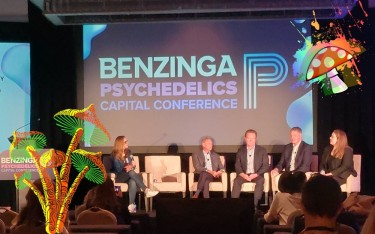
Psychedelics Pending Patents: Can A Company Own Psilocybin Forever and Ever?
An interesting money grab is taking place in the psychedelics space as Cannabis.net first hinted at during their review of the Benzinga Psychedelics Conference in Miami. They covered the general subject of how companies can make money in mushroooms and what is the homerun, retirement type money grab going on. The subject is covered here in the article:
But wait, how is anyone going to get rich in psychedelics to begin with? The big homerun pitch is in the creation of as many novel molecules as a company can create and then get a patent on them as soon as possible. There are thousands of patents being sent in by early state psychedelic companies as part of a “molecule land grab” if you will, being that if you own the patent on XYZ novel molecule, and it later helps to reverse dementia in seniors, guess what? You just bought yourself an island.
Smart money is setting up their companies in this manner in order to someday, fingers crossed, be bought by Big Pharma. An IPO or sale to Big Pharma is the homerun, so having IP (intellectual property) many at experts feel is the key to a big payday down the road. If your company has a patent on 4,000 novel molecules that need research, the odds are better one of them turns out to be medically miraculous, as opposed to a company that may have 500 novel molecule patents. These novel molecules, many with no research being done on them, are like little lottery tickets for these very small psychedelics companies. Enveric Biosciences is publicly traded and is aggressive in following this model. Psychedelics also has an ETF, from AdvisorShares, the symbol is PSIL, for psilocybin.
Well, it seems that companies are trying to go for the trillion dollar home run itself, psilocybin!
The real crystal structures of medicinal psilocybin were revealed on December 20, 2021, thanks to ground-breaking research carried out by the Usona Institute, a 501(c)(3) non-profit medical research organization with its headquarters located in Madison, Wisconsin. This finding represents an important understanding of the innate traits of the plant’s polymorphs that had remained hidden up to this point.
However, this revelation has sparked a contentious debate within the psychedelics sector regarding the pursuit of synthetic psilocybin patents by Compass Pathways (NASDAQ: CMPS), a prominent player in psychedelics product development. They claim to have discovered essentially the same polymorph that the Usona research has now documented.
The recent study from the Usona Institute elucidated the experimental hurdles encountered in unraveling the crystallographic mystery of synthetic psilocybin, shedding light on the polymorphs, distinct crystalline structures naturally arising from synthetic psilocybin production.
Usona asserts that their study unequivocally demonstrates the recurrent occurrence of three psilocybin polymorphs resulting from the well-established crystallization process. These polymorphs have reportedly manifested across numerous instances in the history of psilocybin synthesis dating back to 1959.
In essence, the study posits that there are no groundbreaking findings to be gleaned from this research.
However, Compass Pathways holds a divergent viewpoint. The company claims to have pioneered polymorph A, the crystalline form of psilocybin utilized in their synthesized formulations, and is seeking to patent it. Yet, experts caution against hasty conclusions.
Navigating the Patent Dilemma
According to the Usona team of chemists and collaborating crystallographers, they have successfully deciphered crucial psilocybin crystal structures by analyzing powder X-ray diffraction (PXRD) data collected at the Advanced Photon Source synchrotron at Argonne National Laboratory.
During the course of Usona’s process-scale crystallographic investigation, three distinct crystalline forms of psilocybin were consistently observed: hydrate A, polymorph A, and polymorph B. While the crystal structure of hydrate A had previously been resolved using X-ray diffraction, Usona’s study introduces novel solutions for the crystal structures of the two anhydrates, polymorphs A and B, which were previously unidentified despite being part of the crystalline structure reported in the 1970s.
Dr. Alexander Sherwood, the lead author of the study and a medicinal chemist at Usona, emphasized that their approach involved piecing together available clues to construct a comprehensive understanding of the three psilocybin polymorphs. He stated, “The process of isolating and crystallizing pure psilocybin has been consistently replicated since its initial report in 1959, and various historical indicators pointed towards the existence of three psilocybin polymorphs resulting from this process.” Sherwood added, “The crystal structure solutions effectively amalgamated all historical evidence and data with precision and sophistication. By consolidating this information, a coherent and compelling narrative emerged regarding psilocybin crystallization.”
And Then An Unexpected Turn
The release of fresh information from a nonprofit dedicated to furthering our knowledge of psilocybin has provoked a dispute between corporations hoping to profit from new discoveries by obtaining patent protection and traditionalists who oppose psilocybin’s patenting.
Open Compass Pathways. COMP 360 is a synthetic psilocybin formulation made using crystalline psilocybin, created by this business. Compass Pathways received its fifth U.S. patent (U.S. Patent No. 11,180,517) from the U.S. invention and Trademark Office (USPTO) in November 2021. The invention covers crystalline psilocybin therapy approaches for treatment-resistant depression (TRD).
However, a petition filed on December 15 aims to challenge the patent granted on March 16, 2021. Further petitions challenging Compass’s patents are anticipated from Freedom to Operate (FTO), a non-profit organization dedicated to combating erroneous and unjustly issued patents in support of scientific advancement and education.
The December 15 FTO petition cited expert declarations from Dr. Sven Lidin (Dean at Lund University in Sweden) and Dr. James Kaduk (Professor of Chemistry at Illinois Tech and contributor to the Usona study). They assert that “Polymorph A” is merely a blend of known psilocybin polymorphs, rendering Compass’s patent invalid for claiming a non-existent polymorph.
This development raises questions about whether Compass can legitimately claim to have identified a new crystalline structure—a purported novel variant as mentioned in their patent application—for their synthetic psilocybin. Does the revelation by Usona and the contentions in the petition now nullify Compass Pathway’s patents on synthetic psilocybin?
Usona researchers also touched upon this matter in their study, recommending revisions to characterizations in recently granted patents that incorrectly depict crystalline psilocybin as a single-phase “isostructural variant.”
Simply put, the legitimacy of Compass’s patents utilizing crystalline psilocybin is up for debate—potentially rendering them invalid.
Yet, the clash between the Usona Institute and Compass Pathways underscores a broader issue between non-profit organizations in the psychedelics realm, such as Usona, focused on developing and enhancing therapeutic solutions for human ailments, and for-profit entities like Compass, aiming to establish control over the access and utilization of a natural substance.
This conflict raises pertinent questions for the psychedelics community: Who should have the authority to commercialize and regulate psilocybin? Or, perhaps more fundamentally, should such commercialization even be pursued?
The proliferation of patent applications has prompted the UC Berkeley Center for the Science of Psychedelics to launch a patent tracker. This initiative aims to monitor the progress of patent applications through the U.S. Patent and Trademark Office’s review process. The center highlights that a range of entities, including nonprofits, pharmaceutical firms, startups, and academic institutions, are vying to patent specific psychedelic compounds and formulations.
Carey Turnbull, the founder and director of FTO, articulates a nuanced perspective in a letter, stating, “No one disputes Compass’s role in manufacturing and distributing psilocybin for medical purposes, including myself. However, Compass’s efforts to monopolize psilocybin production and distribution raise concerns.” He adds, “(Compass) is seeking patents for inventions they did not create. While patents are an integral aspect of the system, the pursuit of patents that appropriate existing knowledge and then restrict its use represents a misuse of the system.”
Bottom Line
The clash over psilocybin patents epitomizes a broader ideological conflict within the psychedelics community, raising profound questions about ownership, commercialization, and ethical stewardship. As the debate intensifies and legal challenges unfold, it becomes increasingly clear that the future of psilocybin lies at the intersection of scientific innovation, corporate interests, and societal values. The outcome of this dispute will not only shape the landscape of psychedelic research and development but also have far-reaching implications for the accessibility and regulation of these substances. As stakeholders navigate these complex issues, it is imperative to prioritize transparency, collaboration, and the collective pursuit of knowledge for the betterment of humanity.
WHAT IS PSYCHEDELICS ALL ABOUT RIGHT NOW, READ ON…
BENZINGA PSYCHEDELICS SHOW – IS THIS WEED 2.0?
- SEO Powered Content & PR Distribution. Get Amplified Today.
- PlatoData.Network Vertical Generative Ai. Empower Yourself. Access Here.
- PlatoAiStream. Web3 Intelligence. Knowledge Amplified. Access Here.
- PlatoESG. Carbon, CleanTech, Energy, Environment, Solar, Waste Management. Access Here.
- PlatoHealth. Biotech and Clinical Trials Intelligence. Access Here.
- Source: http://cannabis.net/blog/news/the-billion-dollar-psilocybin-patent-race-can-one-company-actually-patent-the-psilocybin-molecu




